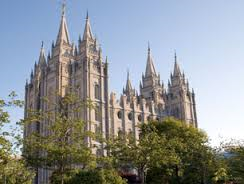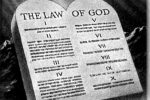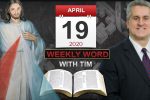Mormonism and the Question of Authority

Catholics and members of “The Church of Jesus Christ of Latter-day Saints,” the Mormons, can agree on at least one very important principle. Both Catholics and the LDS believe in an authoritative, hierarchical Church that speaks with the authority of Christ. The problem with the Mormon attempt to claim apostolic authority is the obvious fact that there was no such Mormon “church” until less than 200 years ago. The informed Catholic need only ask the question: “Why would I leave the Catholic Church which was, as a matter of history, founded by Jesus Christ, and received apostolic authority directly from Christ and the apostles to join the LDS? The bishops in union with the Pope are the true successors of the apostles and possess apostolic authority.”
The Great Apostasy That Could Never Be
The Mormon response to this Catholic question is to claim the Church Jesus Christ established fell into, not just an apostasy, but a total and complete apostasy after the death of the last apostle. Moreover, they maintain biblical texts like Amos 8:11-14 and II Thessalonians 2:1-4 (which we will examine below), among others, positively teach this to be so. Thus, the contention is made that the true Church of Christ did not exist at all for some 1,800 years. It has been re-established through another Testament given to Joseph Smith and “The Church of Jesus Christ of Latter-Day Saints.”
A great place to begin a discussion on this point is with the biblical texts used by Mormons in an attempt to demonstrate their position. Let’s begin with the Prophet Amos who prophesied in Israel ca. 785 BC. Among other things, he warned of the coming destruction of Israel that would, in fact, occur in 721 BC because of her idolatry (see chapters six and seven). Amos 8:11-14 reads:
“Behold, the days are coming,” says the Lord God, “when I will send a famine on the land; not a famine of bread, nor a thirst for water, but of hearing the words of the Lord. They shall wander from sea to sea, and from north to east; they shall run to and fro, to seek the word of the Lord, but they shall not find it.”
This text speaks of an apostasy in ancient Israel, not after the death of the last apostle in the New Testament. But even this apostasy was not total; it does not qualify to be the apostasy Mormons claim it to be. In the very next chapter—9:8-10—Amos makes this very clear.
“Behold, the eyes of the Lord God are upon the sinful kingdom, and I will destroy it from the surface of the ground; except that I will not utterly destroy the house of Jacob,” says the Lord. “For lo, I will command, and shake the house of Israel among all the nations as one shakes with a sieve, but no pebble shall fall to the ground. All the sinners of my people shall die by the sword, who say, ‘Evil shall not overtake or meet us.’”
There were many times in Old Testament salvation history when priests and prophets were corrupt (cf. Lam. 4:13, Ez. 22:22-26, Zeph. 1:4, Mic. 3:5), prophets had no vision from the Lord, prophesied falsely (cf. Lam. 2:14, Jer. 23:26-31), or at times there were no prophets at all (cf. Ps.74:9). Apostasies were frequent in the Old Testament, but never total. There was always a faithful remnant.
Even When God’s People Are Faithless – God Remains Faithful
When one examines the entire Old Testament, one can readily see that in the midst of good times and bad—times of faithlessness and faithfulness—there was one constant: The existence of the High Priesthood and a God-ordained hierarchy as detailed in Exodus 28 and Deuteronomy 17. It was God himself who established and gave authority to this hierarchy in order to guide the children of Israel. The High Priest, or those to whom the High Priest delegated authority, had the power to deliver the oracle of God to His people. Deuteronomy 17:8-12 is an example of the divine origin of this historical fact:
If any case arises requiring decision between one kind of homicide and another, one kind of legal right and another, or one kind of assault and another any case… which is too difficult for you, then you shall… go up to… the Levitical priests, and to the judge who is in office in those days, you shall consult them, and they shall declare to you the decision. Then you shall do according to what they declare… you shall be careful to do according to all that they direct you… The man who acts presumptuously, by not obeying the priest who stands to minister there before the Lord your God, or the judge… shall die.
According to Exodus 28:30, the High Priest had what was called the “Urim and the Thummim” on the breastplate of his vestments whereby he would bear the sins of the people of Israel when he went before the Lord in the temple. Through this gift of God the High Priest would also hear the word of God and proclaim divine oracles from God.
Even during such a corrupt time as we find in the book of Judges, we see this gift in operation in Israel. This was a time characterized by these words from Judges 17:6: “…every man did what was right in his own eyes.” It was a time of rebellion and disobedience; yet, even then the ministry of the High Priest and the gift of “the Urim and the Thummim” was alive and functioning. We see one example of this in Judges 20:18-28. Israel is recorded to have consulted God through “Phineas the son of Eleazar the son of Aaron” who was High Priest at the time and they received the oracle of God through him. They may not have always consulted the Lord, nor did they always obey him when they did, but God was always there for them through the ministry of his priests.
In fact, Our Lord Jesus Christ Himself acknowledged the existence of this hierarchy and its authority during his earthly sojourn. In Matthew 23:2-3, Jesus commanded his apostles: “The scribes and Pharisees sit on Moses’ seat; so practice and observe whatever they tell you, but not what they do; for they preach, but do not practice.” Even the apostles had to obey the scribes and Pharisees who spoke in an official capacity as God’s authority in Israel. Moreover, St. John the Apostle acknowledged the authority of the High Priest to be valid and effective even though the person occupying the office at the time was personally corrupt (see John 11:47-52).
A New Covenant Apostasy?
A sharp Mormon missionary may contend that even if the Old Testament People of God didn’t completely apostatize, St. Paul prophesied the New Covenant People of God would in II Thessalonians 2:1-3:
Now concerning the coming of our Lord Jesus Christ and our assembling to meet him, we beg you, brethren, not to be quickly shaken in mind or excited, either by spirit or by word, or by letter purporting to be from us, to the effect that the day of the Lord has come. Let no one deceive you in any way; for that day will not come, unless the rebellion comes first, and the man of lawlessness is revealed, the son of perdition.
St. Paul used the Greek word apostasia in verse three—translated as “the rebellion”—to describe it. He declared this apostasy must first come before Jesus would come again. And after all, did not the Jews themselves reject the Messiah and apostatize? Does this not at least demonstrate that an apostasy is possible?
First of all, not all of Israel apostatized. The apostles, Mary, and the earliest disciples were mostly Jews so obviously not all in Israel fell away from God. And II Thessalonians never says, nor is there one shred of biblical evidence elsewhere to say, a total apostasy would ever happen. Apostasy, yes! But total apostasy, no! But even more important to the point is this: A total apostasy as taught by the LDS is not only never mentioned in Scripture, but it is impossible according to Scripture for at least three reasons.
1. Old Testament prophecies concerning the New Covenant and the then future coming of the kingdom of God, the Church, describe it as perpetual and indefectible. For example, Daniel 7:13-14:
I saw in the night visions, and behold, with the clouds of heaven there came one like a son of man (Jesus), and he came to the Ancient of Days and was presented before him. And to him was given dominion and glory and kingdom, that all peoples, nations, and languages should serve him; his dominion is an everlasting dominion, which shall not pass away, and his kingdom one that shall not be destroyed” (emphasis added, see also Isaiah 9:6-7 and Daniel 2:44).
2. The New Testament describes the Church as indefectible as well.
And Jesus came and said to them, “All authority in heaven and on earth has been given to me. Go therefore and make disciples of all nations, baptizing them in the name of the Father and of the Son and of the Holy Spirit, teaching them to observe all that I have commanded you; and lo, I am with you always, to the close of the age” (Mt. 28:19-20, emphasis added).
…and of his kingdom there will be no end (Lk. 1:33).
And I tell you, you are Peter, and on this rock I will build my church, and the powers of death shall not prevail against it. I will give you the keys of the kingdom of heaven, and whatever you bind on earth shall be bound in heaven, and whatever you loose on earth shall be loosed in heaven (Matt. 16:18-19, emphasis added).
The LDS claim these quoted texts merely speak of the ultimate triumph of the Church, but that they do not mean there could not be a total apostasy in the centuries between the time of the apostles and that final triumph through the LDS. This contention leads us to my third and perhaps most definitive reason to say a total apostasy is impossible:
3. St. Paul uses most explicit terms in his letter to the Ephesians eliminating the possibility of a total apostasy. In Ephesians 1:22, he describes the Church as “[Christ’s] body, the fullness of him who fills all in all.” This Church, he goes on, is “built upon the apostles and prophets, Christ Jesus himself being the chief cornerstone” (2:20). Indeed, Paul describes the Church as being the instrument God has chosen so that “through the Church the manifold wisdom of God might now be made known to the principalities and powers in heavenly places” (3:10). Paul then reminds us, as we have already seen, this Church must have apostles, prophets, pastors, evangelists and teachers (cf. 4:11). Why? “For the equipment of the saints… for building up the body of Christ… so that we may no longer be children, tossed to and fro and carried about with every wind of doctrine…” (4:12-14).
According to St. Paul, God gave us the Church so that we may know with certainty the truths of the Faith. This is by no means the only reason for the existence of the Church, but it is a central reason. But most important to our purpose here, we need to consider Ephesians 3:20-21:
Now to him who by the power at work within us is able to do far more abundantly than all that we ask or think, to him be glory in the Church and in Christ Jesus to all generations, forever and ever. Amen.
This Church that St. Paul is describing in Ephesians will be here to all generations (pasas tas geneas, “all the generations”) forever and ever. This biblical text eliminates the possibility of a total apostasy for even one generation, much less 1,800 years!
A Final Question and Comment
According to Matthew 18:15-18, Jesus gave us a definitive commandment: He said:
If your brother sins against you, go and tell him his fault, between you and him alone. If he listens to you, you have gained your brother. But if he does not listen, take one or two others along with you… If he refuses to listen to them, tell it to the church; and if he refuses to listen even to the church, let him be to you as a Gentile and a tax collector. Truly, I say to you, whatever you bind on earth shall be bound in heaven, and whatever you loose on earth shall be loosed in heaven.
Mormons and Catholics agree that Christ was here directing the faithful to obey the Church that he established and that we can be confident to do so because the true Church to which Jesus was leading us would never steer us away from God. The question is: what Church is being referred to here? Mormons say it is the LDS “church.” Catholics say it is the Catholic Church. How do we know which is true?
One way to know is to ask another simple question: What if you were living in, let’s say, 1805, and you were to read this very passage from St. Matthew. You could know that Jesus would never lead you to a “church” with no one who could speak for him. In obedience to Jesus, where would you go? The LDS did not exist yet. Jesus is the way, the truth and the life. He would never lead us astray or command us to follow error. If the true church did not exist on this earth for 1,800 years, then Jesus misguided millions into obeying an error-filled church with no apostolic authority. That would be unthinkable.
If you like this post and would like to learn more, click here.






